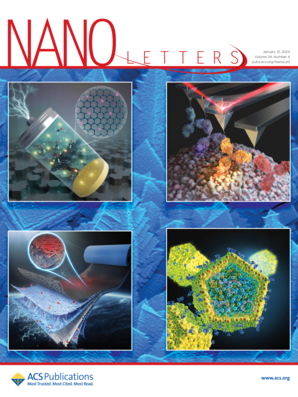Atomically Unveiling the Phase Evolution in Weakly Coupled Layered Transition-Metal Phosphorus Trichalcogenide by Chalcogen Doping
IF 9.1
1区 材料科学
Q1 CHEMISTRY, MULTIDISCIPLINARY
引用次数: 0
Abstract
The stacking configuration significantly influences the properties of van der Waals (vdW) layered magnets by dictating crystallographic and magnetic symmetries. Transition-metal phosphorus trichalcogenides (MPX3, X = S, Se) intrinsically exhibit diverse stacking polytypes, being an optimal platform for magnetic phase engineering. Unlike MX2, where chalcogen doping has a minimal impact on stacking, MPX3 allows stacking control via elemental substitution. However, the atomic-scale mechanisms governing stacking variations remain unclear. Using scanning transmission electron microscopy (STEM) and density functional theory (DFT) calculations, we reveal that in 3d transition metal MPX3, tuning the S/Se ratio induces a transition from the C2/m to R3̅ phase due to modified interlayer S–S/Se–Se and P–P interactions. In contrast, stacking control becomes challenging for 4d CdPX3, due to relatively weak interlayer coupling. These insights provide a stacking basis for stacking polytypes in MPX3, paving the way for tuning magnetic couplings via stackingtronics.

用硫掺杂原子揭示弱耦合层状过渡金属三卤代磷的相演化
堆叠构型通过决定晶体学和磁对称性,对范德华(vdW)层状磁体的特性产生重大影响。过渡金属磷三钙化物(MPX3,X = S、Se)本质上表现出多种堆叠多型性,是磁相工程的最佳平台。与 MX2 不同,MPX3 允许通过元素替代来控制堆叠,而 MX2 中掺杂的查尔根对堆叠的影响微乎其微。然而,有关堆叠变化的原子尺度机制仍不清楚。利用扫描透射电子显微镜(STEM)和密度泛函理论(DFT)计算,我们揭示了在 3d 过渡金属 MPX3 中,由于层间 S-Se/Se-Se 和 P-P 相互作用的改变,调整 S/Se 比率可诱导从 C2/m 到 R3̅ 相的转变。相比之下,由于层间耦合相对较弱,4d CdPX3 的堆叠控制变得具有挑战性。这些见解为 MPX3 的堆叠多类型提供了堆叠基础,为通过堆叠电子学调整磁耦合铺平了道路。
本文章由计算机程序翻译,如有差异,请以英文原文为准。
求助全文
约1分钟内获得全文
求助全文
来源期刊

Nano Letters
工程技术-材料科学:综合
CiteScore
16.80
自引率
2.80%
发文量
1182
审稿时长
1.4 months
期刊介绍:
Nano Letters serves as a dynamic platform for promptly disseminating original results in fundamental, applied, and emerging research across all facets of nanoscience and nanotechnology. A pivotal criterion for inclusion within Nano Letters is the convergence of at least two different areas or disciplines, ensuring a rich interdisciplinary scope. The journal is dedicated to fostering exploration in diverse areas, including:
- Experimental and theoretical findings on physical, chemical, and biological phenomena at the nanoscale
- Synthesis, characterization, and processing of organic, inorganic, polymer, and hybrid nanomaterials through physical, chemical, and biological methodologies
- Modeling and simulation of synthetic, assembly, and interaction processes
- Realization of integrated nanostructures and nano-engineered devices exhibiting advanced performance
- Applications of nanoscale materials in living and environmental systems
Nano Letters is committed to advancing and showcasing groundbreaking research that intersects various domains, fostering innovation and collaboration in the ever-evolving field of nanoscience and nanotechnology.
 求助内容:
求助内容: 应助结果提醒方式:
应助结果提醒方式:


